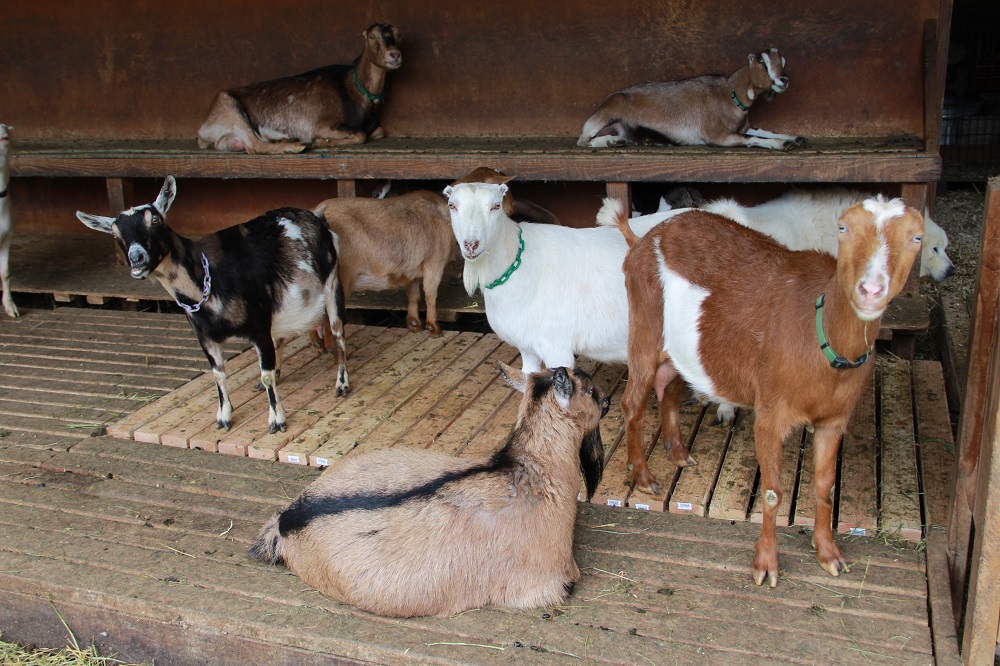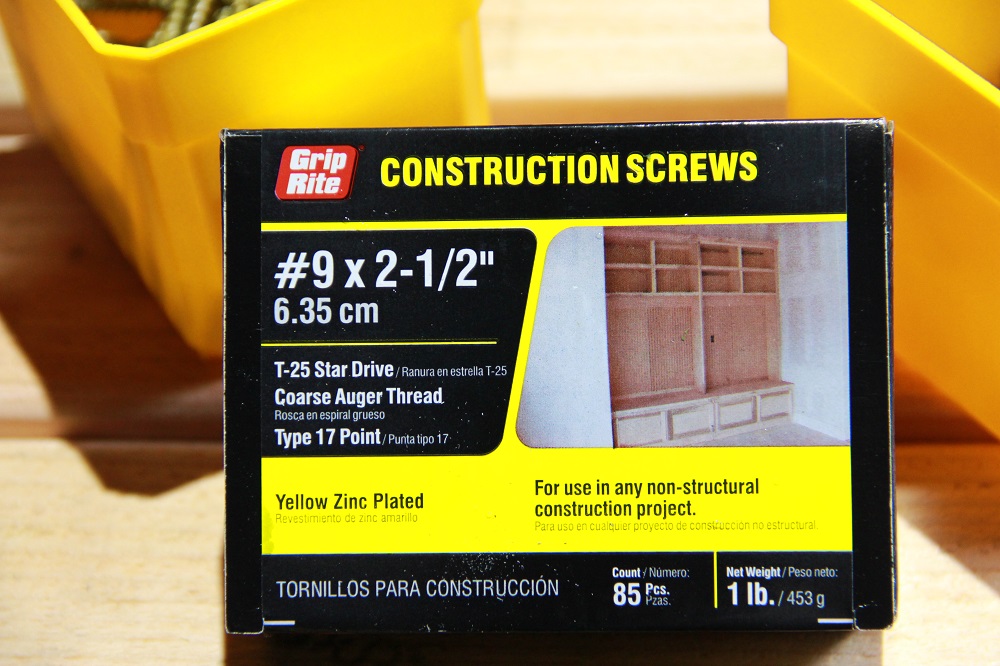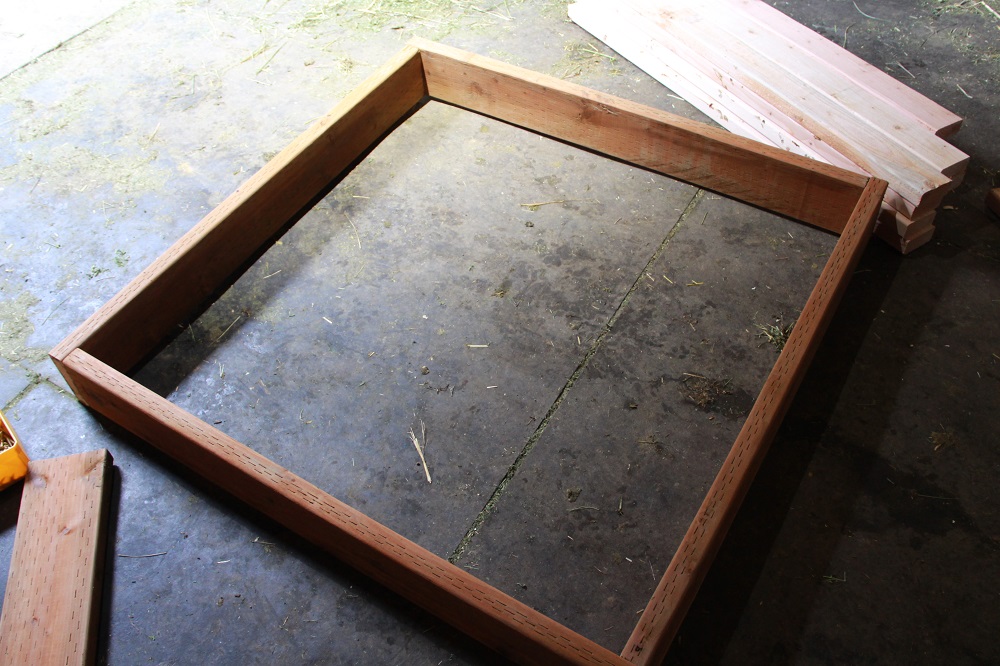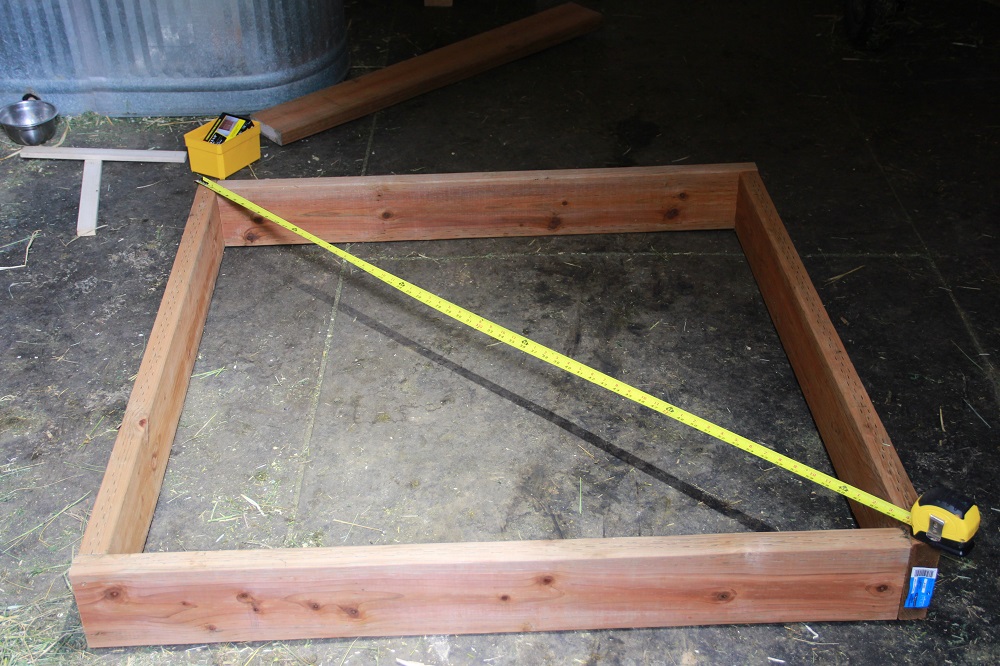How to Build Sectional Raised, Slatted Flooring for Goats

Hands down, raised, slatted flooring for goat housing wins the prize for ease of maintenance, cost over time, and, best of all, goats love it! I call this type of flooring “goat decks”.
Goat decks allow the manure to fall through the slats (mostly) and urine runs through and/or dries. The manure collects without being compacted by the goat’s hooves, meaning it is light and fluffy and super easy to scoop out when the decking is tipped up for cleaning every few weeks. Very little, if any, feedstuffs or other bedding, makes it through the cracks resulting in a higher value manure for gardens and possible sale.
The initial investment, not counting labor, is about 3.00 per square foot. The instructions in this post are for building two 4×4’ sections, or 32 square feet. Given that a bag of shavings will cost most people about 10.00, this one-time investment will save you a lot of money over time. For miniature breeds, space the decking at ½ inch. For standard breeds at 5/8 inch. It works well even with kids in the pen.
I keep one interior space bedded traditionally – with shavings and straw – but am progressively covering the rest of the sheltered space with goat decks. Here in Oregon our coldest winters are only in the teens, usually, and even then, many of the goats prefer the decks to the bedded area for sleeping. There is no draft below them and the manure must build up some heat that makes them comfortable.
We average having to clean under ours about every 6 weeks (that was with a larger herd than we have now), but it depends on the weather – when nice, they don’t spend as much time in the sheltered areas, of course, so manure build-up under the decks diminishes.
Cleaning involves daily raking (with a metal leaf rake) the tops to clear the tops and slats, spraying the undersides with vinegar after cleaning underneath, and occasionally using a hay-hook to clean the spots between the slats where the under-framing prevents manure from falling through. I built the first decks about six years ago and they are still in great shape.
Materials Needed (for two 4’x4’ sections)
5 – 8 foot pressure treated 2×6’s (or 2’x8’s if you want them a little higher, but they will also be heavier)
12 – 8 foot 2×4’s
18 – 3 inch exterior screws
60 – 2 ½ inch exterior screws
2 – ½ – 5/8 inch thick spacers (short pieces of wood to get the deck spacing even)
Construction (takes about 1 ½ hours if you have a bit of experience building)

Prep
- Cut 4 2×6’s into eight 45” sections
- Cut 1 2×6 into two 43 ½ inch sections
- Cut 2×4’s in half (24 48” sections)
Assemble Base
- Arrange 45 inch sections of pressure treated wood with ends overlapping as shown in 2nd photo from left (alternate the pattern) and connect with 3 of the longer screws at each corner. This will form a square that is 46 1/2 inches on each side. Double check the measurements before assembling to make sure that you have the boards overlapped properly.
- Place the 43 ½ inch piece of pressure treated wood in the center and secure through the side with 3 of the long screws.
- Check “the square” by running a tape measure diagonally from each corner. They must measure the same distance. If not, adjust by pushing the long side at one corner towards the short side.
Install the Decking
- Beginning at one edge (with the decking boards running across the center support board)
- Overlap the first board ½ inch at each end and 1 inch along the long edge. Secure in place with 2 of the shorter screws at each end, one in the center support, and a couple along the long edge.
- Use the spacers to place the next board and secure it in place.
- Continue as in step 3 until all decking is in place.
Repeat for 2nd section.










Where I live it gets quite cold (last night it was 4*F), with lots of snow and rain. I use wooden pallets with plywood screwed on top to raise my goats off the wet cold ground…I was worried that just having the slats would allow cold air through. Now, after reading your article, I’m wondering if it would be better if I removed the plywood? I know your weather is different…advice?
Hi Candace, If the slats aren’t too far apart and there is a bit of manure underneath, AND they aren’t super far off of the ground, I think it would be nicer for them. At least try it on one pallet and see who enjoys using it. If you have one, you can try checking the temperature above them with an infrared thermometer gun. It’s a nice way to learn about the temperature conditions for the goats. 4 F is so cold! Do let me know if you try it and if they like it!
Holistic Goat Care: A Comprehensive Guide to Raising Healthy Animals, Preventing Common Ailments, and Troubleshooting Problems Jun 7, 2017
Hi, I live in LaCenter Washington so our winters aren’t bad and we were wondering about the ammonia smell seeping into the wood. How have you dealt with that or have you not found it to be a problem? We are definitely going to do this, but we were wondering if maybe we should go with trex as it might be less absorbent.
Hi there, When we clean underneath, every 6 weeks or so, I spay the bottoms with vinegar (regular dilution off of the grocery shelf, but you could use stronger – ag strength they often call it) and then sometimes I spray the top where they have peed. But the ammonia itself isn’t detrimental to the wood, just can be smelly over time.
I’ve been through LaCenter, pretty area! My dad used to live in Bow. 🙂
Best to you!
Oh, if you build them, I’d love to share a photo on my FB page!
Gianaclis
I’m planning out our new barn now and am planning on incorporating goat decks. I have two questions. Firstly, do you rake the tops parallel or perpendicular to the gaps? I ask as I am planning on raking towards a central aisle and my decks won’t be squares, but rectangles (so I won’t be able to test the efficacy myself and then change it later). Secondly, is there any reason why I couldn’t use 2×4 lumber for the bases rather than 2×6?
Hi there, rake parallel, most of the pellets will fall through and the rake tines will help clean the grooves. You could most certainly use 2×4, but the manure will build up more quickly. Still, it’s an option and would make the panels easier to lift. Happy Holidays!
What do you use for the flooring under the decks? plywood?
Hi Joseph, they sit directly on the ground–in our case, we used a base of decomposed granite, known in the west as DG.
Do you think the decks would work ok over a plywood floor? We plan on building a raised goat shed to keep the goats off the ground. If plywood wouldn’t work I will have to redesign a little to use the dirt floor.
Because of the moisture and heat from the manure, I would think it would rapidly degrade most plywood. It might be an expensive loss. Or the plywood could sag. Could you put horse stall mats down instead? What is holding the plywood up? If you’d like to email me a cross section drawing of the floor and wall connections, I can take a look.
Pingback: ≫ Bricolaje – Cubiertas de cabra
Hi. Is it a good option to have a concrete floor underneath the slats? Currently have my goats sitting on wooden pallets which are directly on the ground. I find that if i don’t rake up within 2 to 3 days, i get a lot of ants and worms around the droppings. I am in a summer season at the moment.
Hi there, Ours are on the ground and we don’t have that problem. But when we have used pallets, we do. It’s likely due to the increased soil contact. With the decks there is minimal, making it too dry for worms and ants. We also used pressure treated wood for the earth contact wood, so that helps too. You must be from the southern hemisphere to be in summer now! Good luck and thanks for writing 🙂